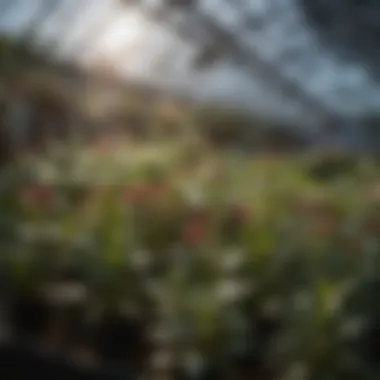Top LED Grow Lights for Optimal Plant Growth in 2023


Intro
LED grow lights have revolutionized how we approach plant cultivation, particularly in environments where natural light is limited. Choosing the right grow light can make a significant difference in plant growth and health. This article delves into crucial aspects of LED grow lights, focusing on their energy efficiency, light spectrum, usability, and the latest innovations in the field.
As we explore various products available on the market, potential buyers will gain insights into crucial features that enhance growth for both indoor and outdoor plants. Understanding these lights is essential not only for professional growers but also for home gardeners seeking optimal development for their plants.
Key Considerations for Selecting LED Grow Lights
Before diving into specific products, it is important to understand the key factors influencing the choice of LED grow lights. Here are the prominent themes to consider:
- Energy Efficiency: LED lights are renowned for their low energy consumption. This means not only lower electricity bills but also an improved environmental footprint.
- Light Spectrum: The spectrum emitted by LED lights plays a crucial role in photosynthesis. Different plant species have varied light needs, and understanding these requirements can lead to better growth outcomes.
- Usability: Features such as adjustable spectrum settings, timers, and sizes can enhance the practicality of lighting options, making them suitable for different growing spaces.
Prelude to LED Grow Lights
LED grow lights have revolutionized how we approach indoor and outdoor plant cultivation. Their significance lies not only in promoting plant health but also in enhancing energy efficiency. In the modern era, where environmental concerns are paramount, the shift from traditional lighting systems to LED technology is marked by sustainability and cost-effectiveness. Understanding the fundamental aspects of LED grow lights is essential for anyone invested in horticulture, whether for professional purposes or personal hobby.
Overview of Grow Lights Technology
Grow lights serve as artificial light sources that mimic sunlight, helping plants to grow in environments lacking sufficient natural light. The newest variations include not just LEDs but also other artificial light types like fluorescent or HID lights. However, LEDs have gained particular attention due to their lower energy consumption and longer lifespan. As technology advances, LED grow lights have become more efficient, compact, and adaptable to different growth stages of plants.
The important developments in LED technology have embraced a wide range of light spectrums, which cater to various plant species and growth phases. The integration of smart technology has allowed users to adjust light intensity and spectrum through mobile applications. This adaptability ensures that the specific needs of plants are met, providing them with the right conditions to flourish.
Light Spectrum and Its Importance for Plants
The light spectrum plays a crucial role in plant photosynthesis and overall growth. Plants utilize different light wavelengths for various growth processes. Generally, light can be divided into two critical categories: blue light and red light, both of which are essential for growth.
- Blue Light: This spectrum is vital for leaf development and vegetative growth. It encourages strong stems and foliage, which are foundational for producing flowers and fruits.
- Red Light: This spectrum is key during the flowering and fruiting stages. It not only helps in blooming but also influences the size and quality of the fruits produced.
Understanding the significance of the right light spectrum is crucial for optimal plant development. When selecting LED grow lights, one must consider how effectively these lights can replicate the necessary wavelengths for different plant needs.
The objective is to provide plants with a balanced light regimen that promotes consistent growth throughout their life cycle, ensuring the successful development of both leaves and blooms.
In summary, the introduction to LED grow lights encapsulates the importance of appropriate lighting in cultivating healthier plants. By grasping the technology and light spectrum needed for various growth stages, cultivators can make informed decisions on the most suitable LED grow lights for their specific needs.
Factors to Consider When Buying LED Grow Lights
When selecting LED grow lights, several critical factors must be taken into account. These factors ensure that the chosen lights meet the specific needs of your plants while also fitting within your budget and long-term plans.
Energy Efficiency and Cost
Energy efficiency plays a significant role in reducing long-term operational costs for LED grow lights. Unlike traditional lighting options, LED technology offers less power consumption, providing the same or even improved brightness and light quality for plants. This efficiency not only lowers electricity bills but also contributes to a smaller carbon footprint.
In addition to energy savings, initial costs should be evaluated. While the upfront investment for high-quality LED grow lights may be higher compared to alternatives like fluorescent bulbs, the long-term benefits often justify this expense. Over time, LEDs can provide substantial savings due to their durability and lower maintenance needs. This balance between upfront costs and prolonged savings is crucial for making informed decisions.
"An ideal LED grow light strikes the right balance between energy efficiency and performance to ensure optimal plant growth."
Light Intensity and Coverage Area
Light intensity is essential for effective photosynthesis in plants. Different plants require varying levels of light intensity for optimal growth, and LED grow lights should be selected based on the specific needs of the plants you are cultivating. High-intensity lights are beneficial for plants that thrive in bright conditions, while moderate levels can support plants with lower light requirements.
Coverage area is closely related to intensity. It defines how much space the grow light can effectively illuminate. Buyers should assess their growing space and choose lights that can adequately cover that area. For larger spaces, multiple lights may be necessary to ensure that all plants receive sufficient light.
Additionally, adjustable mounting heights can enhance coverage and optimize light intensity by allowing users to tailor the distance between the light and the plants.
Durability and Lifespan of LED Lights
The durability of LED grow lights is notably higher compared to conventional lighting systems. Quality LEDs are designed to withstand varying environmental conditions, making them suitable for both indoor and outdoor gardening. Factors such as heat resistance and humidity play a crucial role in determining the longevity of these lights.
The lifespan of LED lights is another important consideration. Most LEDs can last up to 50,000 hours or more, significantly reducing the frequency of replacement. This longevity translates to cost savings over time and less waste, further emphasizing the sustainability aspect of using LED technology.
Top LED Grow Lights Available in the Market


Selecting the right LED grow light is crucial for anyone looking to maximize plant growth, whether indoors or outdoors. The market is crowded with a diverse selection of lights, each boasting various features and benefits. Understanding the top LED grow lights ensures that gardeners make informed decisions. Comparing the leading brands and investigating the features of best-selling models can significantly influence the success of plant cultivation.
Comparison of Leading Brands
In the diverse landscape of LED grow lights, brand reputation often plays a significant role in ensuring quality and reliability. Brands such as Viparspectra, Mars Hydro, and Spider Farmer have garnered attention for their innovative designs and performance.
- Viparspectra: Known for its efficiency and reasonable pricing. Many users praise its energy-saving features, making it an attractive option for budget-conscious gardeners.
- Mars Hydro: This brand is associated with robust customer service and high-quality products. Its lights often feature full-spectrum capabilities, promoting better plant growth.
- Spider Farmer: Recognized for their advanced technology, Spider Farmer lights often include features such as dimming options and high PAR output.
When comparing these brands, consider not only the initial cost but also the warranty and support offered. An extended warranty serves as a safety net, assuring users of the product's durability and reliability.
Features of Best-Selling Models
The market’s top models tend to stand out due to specific features that enhance usability and plant growth.
- Full Spectrum Capability: Best-selling LED grow lights often provide a full spectrum of light. This range mimics natural sunlight, supporting plants through all growth stages.
- Dimmability: Some lights come with adjustable output, allowing growers to customize intensity according to plant needs. This is especially useful in delicate stages, such as seedling or flowering.
- Thermal Management: Effective cooling systems are essential for LED lights. Models with built-in fans or heat sinks can help maintain performance and longevity.
- Energy Efficiency: High-quality grow lights provide significant energy savings, reducing operational costs over time.
In summary, selecting one of the top-tier LED grow lights is an investment in your gardening success. Understanding brand reputation and the features of best-selling models can vastly improve the effectiveness of your gardening methods. Always keep your unique requirements in mind when choosing the best light for your setting.
Best LED Grow Lights for Indoor Gardening
Indoor gardening has gained immense popularity due to various factors, such as the need for sustainable food sources and the enjoyment of planting in limited spaces. When it comes to optimizing plant growth indoors, LED grow lights play a crucial role. Their importance lies in their ability to provide specific wavelengths of light that plants require for photosynthesis, which is essential for plant health and productivity.
Choosing the right LED grow light can significantly influence plant yield and vitality. Growers must look for lights that offer a balance of energy efficiency and appropriate light spectrums. Furthermore, the ability to simulate natural sunlight allows for year-round gardening, making this a practical solution for households and enthusiasts alike.
Compact and Efficient Options
For indoor gardening, compact LED grow lights offer an attractive choice. These lights are designed for small spaces, making them perfect for home gardens or urban apartments. Their compact size does not compromise power; instead, they deliver adequate light to support the growth of various plants.
- Space-Saving Design: Compact options ensure that gardeners can enjoy a productive space without being overwhelmed by large equipment.
- Energy Efficiency: Many compact LED grow lights consume less power, which is beneficial for those who want to minimize energy costs.
- Targeted Light Spectrum: Even in smaller fixtures, varying light spectrums can be found, aiding in different growth stages, from seedlings to flowering plants.
These characteristics allow for effective gardening solutions suitable for a wide audience, including families and hobbyists.
Full-Spectrum Lights for Diverse Plants
Full-spectrum LED grow lights provide a range of wavelengths that mimic natural sunlight. This is particularly valuable for indoor gardening as it supports the needs of diverse plant types under one lighting solution.
- Photosynthesis Support: Different plants have varying light requirements. Full-spectrum lights address these needs across the board, helping photosynthesis more efficiently.
- Healthy Growth Stages: Whether plants are in seedlings, vegetative growth, or flowering, full-spectrum lights adjust to support each phase.
- User-Friendly: Many of these lights come with adjustable settings or timers, making them convenient for users of all levels.
Full-spectrum LED grow lights offer versatility, simplifying the gardening process for indoor plant-lovers and contributing to successful growth.
In sum, both compact and full-spectrum LED grow lights are fundamental when considering the best lighting solutions for indoor gardening. By understanding their features, gardeners can select options that deliver quality results in their unique environments.
Best LED Grow Lights for Outdoor Use
The significance of selecting the right LED grow lights for outdoor use cannot be overstated. Outdoor cultivation exposes plants to varying weather conditions, making it crucial to choose lights that can perform reliably under such circumstances. The primary benefits of LED grow lights for outdoor applications include their energy efficiency, long lifespan, and ability to provide a spectrum tailored for plant growth. Moreover, they can help in extending the growing season, especially in regions with shorter sunlight hours.
Weather-Resistant Designs
When it comes to outdoor LED grow lights, weather resistance is a fundamental feature. These lights must endure various climates, including rain, wind, and extreme temperatures. A weather-resistant design ensures that the lights can operate safely and effectively without suffering damage.
Some key characteristics of weather-resistant LED grow lights include:
- Sealed Enclosures: They protect internal components from moisture and dust, preventing electrical failures.
- Durability: Materials used in construction should withstand harsh environmental conditions.
- Heat Resistance: LEDs must handle high temperatures without degrading performance.
Here are some examples of reputable weather-resistant LED grow lights:
- VIPARSPECTRA V300: Known for its robust build and suitability for outdoor gardens.
- MARS HYDRO TS 1000: Offers a high IP rating that ensures protection from the elements.
Solar-Powered Options
Solar-powered LED grow lights present an innovative choice for outdoor gardening, especially in areas with ample sunlight. These lights utilize solar panels to convert sunlight into energy, allowing for sustainable and eco-friendly cultivation.
Advantages of solar-powered LED grow lights include:


- Cost Savings: Reducing electricity costs over time, as they rely on free solar energy.
- Portability: Many models can be easily relocated, making them flexible for various gardening needs.
- Environmentally Friendly: They contribute to reduced carbon footprints and sustainable practices.
Several companies now develop solar-powered LED grow lights, offering a range of options suitable for different budgets and gardening styles. Products like Solpex Solar Garden Lights or Greluma Solar Grow Light provide effective solutions for those looking to maximize outdoor plant growth without additional energy expenses.
It's important to evaluate the typical sunlight exposure of your garden area to ensure these solar options are effective.
User Experience and Feedback
User experience and feedback play a critical role in determining the effectiveness and reliability of LED grow lights. When selecting lighting for plant cultivation, personal experiences shared by other users can provide invaluable insights. Customer reviews and ratings can guide potential buyers on performance, durability, and overall satisfaction. Understanding user sentiments can help differentiate between high-performing lights and less effective alternatives.
One of the primary benefits of considering user feedback is the authentic perspective it offers. These reviews often highlight real-world experiences with different LED grow lights, discussing nuances that product specifications may overlook. Key elements such as ease of installation, actual energy consumption, and the impact on plant growth are usually covered in user feedback. By examining these narratives, potential buyers can make informed decisions that meet their specific needs.
Additionally, user experiences reveal common issues that may arise with certain brands or models. This knowledge is essential when evaluating the risks associated with particular LED grow lights, as it may prevent costly mistakes in purchasing. Furthermore, some reviews might include tips on optimizing the lights for maximum efficiency or suggest alternative products that might have better performance based on user experiences.
"Customer experiences can reveal the practical advantages or limitations of grow lights that technical specifications may not fully convey."
Customer Reviews and Ratings
Customer reviews and ratings serve as a direct reflection of the performance and reliability of LED grow lights. Aggregated on various platforms, these ratings provide an overview of product quality and user satisfaction. Potential buyers should look for products with high average ratings and extensive reviews, as this usually indicates a solid reputation among users. The quantity of reviews can also be an indicator, with a more substantial number suggesting a reliable product with consistent performance.
When analyzing reviews, it is important to differentiate between verified purchases and unsolicited opinions. Verified buyers provide insights grounded in actual usage, while unverified reviews can lack the necessary context or experience. Users often share feedback on crucial aspects such as light intensity, spectrum efficiency, and the energy efficiency of the grow lights they have purchased. Efforts to identify common themes in reviews can shed light on consistent strengths and weaknesses among different models.
- Pros from reviews often include:
- Cons that may arise in reviews include:
- Improved plant health and yield.
- Ease of use and installation.
- Cost-effectiveness over time due to lower electricity bills.
- Issues with heat management.
- Shorter lifespan than marketed.
- Customer service challenges in case of product defects.
Expert Recommendations
Expert recommendations lend additional credibility to the evaluation of LED grow lights. Professionals in the field, such as horticulturists and lighting specialists, usually base their suggestions on extensive experience and research. They understand the complexities of plant growth and can recommend products that best suit specific cultivation goals.
Many experts provide insights concerning light spectrum control, recommended wattage, and the expected coverage area for effective growth. Such insights help potential buyers align their purchase with their individual requirements. Experts may also suggest specific brands or models that have consistently demonstrated quality and efficacy in scientific studies or commercial applications.
Moreover, experts often emphasize the importance of investing in a reputable product rather than opting for cheaper alternatives. Although budget constraints are common, quality LED grow lights can offer better returns over time, whether through healthier plants or reduced energy consumption. By following recommendations from industry professionals, buyers can gain confidence in their choices and avoid pitfalls associated with inferior products.
In summary, combining user experience with expert recommendations provides a comprehensive view of the best LED grow lights available. By leveraging these insights, prospective buyers can be more strategic in their selection, ensuring optimal plant growth and maintaining a suitable environment for cultivation.
Installation and Maintenance of LED Grow Lights
Installation and maintenance of LED grow lights are critical aspects that can significantly influence plant growth and overall efficiency of the lighting system. Correct installation ensures optimal performance, while regular maintenance can prolong the lifecycle of the LEDs, ultimately saving costs and enhancing plant health.
Installation Guidelines for Home Gardeners
For home gardeners, installation of LED grow lights requires careful planning. First, it is essential to assess the space available for the plants. Knowing the dimensions of the area helps in selecting the right number and type of lights.
- Choose the Right Height: Hang LED lights at a height that provides even coverage without overexposing plants to intense light. Generally, a distance of 12 to 36 inches above the plants works well, but this may vary depending on light intensity.
- Consider the Layout: Ensure that lights are positioned to avoid shadows. This may involve using multiple lights if the setup is large.
- Use Reflectors: Reflectors can help in maximizing light efficiency. They redirect light towards the plants rather than allowing it to disperse into the surroundings.
- Electrical Safety: Ensure to follow electrical guidelines. Using surge protectors can safeguard the lights from potential damage due to voltage spikes.
Tip: Always refer to the manufacturer’s installation instructions for specific models. This may include mounting methods, optimal heights, and power setup.
Maintaining LED Lights for Longevity
Maintaining LED grow lights is essential to ensure their long-term efficiency and effectiveness. A few simple practices can significantly extend their lifespan and maintain their performance.
- Regular Cleaning: Dust and grime can settle on the lights, reducing their efficiency. Gently wipe the surfaces with a dry or slightly damp cloth to keep them clean.
- Check Connections: Regularly inspect all electrical connections for signs of wear or corrosion. Ensuring secure connections can prevent malfunction and electrical hazards.
- Monitor Temperature: LED lights generate heat, so it's crucial to ensure that they do not overheat. Adequate ventilation should be provided, especially in enclosed spaces, to maintain a suitable temperature.
- Replace Filters: If using any ventilation systems, ensure to replace filters periodically. Dirty filters can hinder airflow and contribute to overheating.
Regular maintenance practices can help achieve an optimal environment for plants which leads to improved growth rates and health.
By following these installation and maintenance guidelines, home gardeners can ensure that their LED grow lights perform efficiently and effectively, leading to better plant growth and long-term satisfaction with their gardening efforts.
Emerging Trends in LED Grow Light Technology
The development of LED grow light technology is fast and continually evolving. Understanding emerging trends in this field is essential for those interested in optimizing their plant growth strategies. These trends not only enhance the efficacy of plant cultivation but also cater to the varying needs of users, whether they are novice gardeners or seasoned horticulturists.


Smart Technology Integration
One of the most significant trends in LED grow lights is the integration of smart technology. Modern LED systems are now being outfitted with smart features that allow for more precise control over the lighting conditions. Users can remotely operate their grow lights through mobile apps or other smart devices.
Benefits of Smart Technology Integration:
- Remote Monitoring: Users can check their lights and environmental conditions from anywhere, making it easier to manage growth cycles.
- Automated Settings: Smart technology allows for programmable settings based on plant needs, adjusting the light according to stages of growth.
- Data Analytics: Some smart systems offer real-time data analytics, helping the user to understand how environmental factors impact plant health.
However, it is also crucial to consider the potential downsides. Dependence on technology can result in vulnerabilities if systems fail or are hacked. Individuals should evaluate their comfort level with smart technology before making a purchase.
Advancements in Light Spectrum Control
The ability to control and adjust the light spectrum has seen noteworthy advancements. Current systems are designed to provide specific wavelengths that correspond closely to the photosynthetic needs of different plant types.
Key aspects of light spectrum control include:
- Full-Spectrum Emitters: These devices can emit a wide range of wavelengths, promoting optimal growth throughout the plant's life cycle. This versatility is beneficial for grow setups that feature diverse plant types.
- Selective Spectrum Adjustments: Recent models allow users to customize light settings for specific growth stages, such as vegetative phase and flowering phase, ensuring plants receive the necessary spectrum at each stage.
- Improved Efficiency: Recent enhancements in spectrum technology lead to better energy use, translating to lower energy costs while providing sufficient light for plant growth.
Different spectra affect plant growth differently. Proper spectrum control allows for a more tailored growth experience, optimizing yields.
Emerging trends such as these not only enhance the overall user experience but also contribute to more sustainable and efficient growing practices. As the technology progresses, it opens new avenues for those looking to maximize their gardening potential. Understanding these trends can significantly inform purchasing choices and lead to better outcomes in plant cultivation.
Cost Analysis and Budget Considerations
Cost analysis and budget considerations are crucial aspects when choosing LED grow lights. The initial purchase price can be significant, but it often does not capture the full picture. Efficient lighting solutions can offer substantial long-term savings, making it essential to evaluate both upfront costs and ongoing expenses. This section will explore how to analyze costs effectively, the benefits of investing in quality lights, and evaluate budget-friendly alternatives.
Initial Investment vs.
Long-Term Savings
When considering the initial investment in LED grow lights, it is important to balance the upfront cost with the potential long-term savings. LED lights generally have a higher purchase price compared to traditional lights, such as fluorescent or incandescent bulbs. However, they come with advantages that often outweigh these initial costs.
Benefits of LED grow lights include:
- Energy efficiency: LED lights use significantly less power, which can reduce energy bills over time.
- Longevity: Most LED grow lights have a lifespan ranging from 25,000 to 50,000 hours, meaning fewer replacements are required.
- Reduced heat output: Lower heat production decreases cooling costs, especially in indoor environments.
- Better growth results: With more efficient light spectrum use, plants can grow faster and yield better, leading to potential financial gains.
Overall, while the initial investment may seem high, the return in terms of lower bills and better plant production can make LEDs a more economical choice in the long run.
Budget-Friendly Alternatives
For those who are working with limited budgets, there are several affordable alternatives in the market. It is vital to know which products offer good performance without compromising too much on quality. Here are some options and tips:
- Consider smaller wattages: Lower wattage grow lights can still be effective, especially for smaller plants or limited growing areas.
- Shop for sale items: Many retailers have seasonal sales and discounts, allowing you to find high-quality products at a reduced price.
- Look for reputable brands: Affordable brands often have models that provide great value without losing efficiency. Brands like Roleadro, MARS HYDRO, and VIPARSPECTRA offer effective LED options that may not break the bank.
- Second-hand market: Checking platforms like Facebook Marketplace or Reddit can yield good deals on pre-owned grow lights that are still in excellent condition.
Always remember that the right grow lights can lead to flourishing plants, which ultimately enhances your gardening experience.
Epilogue: Making the Right Choice
Choosing the right LED grow lights involves careful consideration of various factors. This article has delved into the essential elements influencing your decision. The importance of selecting adequate lighting cannot be overstated, as it directly impacts plant health and growth. Each grow light technology offers distinct functionalities, catering to unique growing environments and plant needs.
Understanding the energy efficiency, light spectrum, and usability features is key to optimizing your investment. Not only does it enhance plant development, but it also contributes to cost savings over time. Focusing on these considerations enables gardeners, whether seasoned or novice, to make informed choices that align with their specific goals.
The right LED grow lights can significantly affect yield quality, growth speed, and overall plant vitality. Therefore, being aware of the varied options available allows for a tailored approach to your gardening objectives. It is essential to weigh all factors, from initial costs to long-term benefits, ensuring a robust return on investment.
Recap of Key Points
- Energy Efficiency: LED grow lights are known for their lower energy consumption, leading to cost savings.
- Light Spectrum: Understanding the light spectrum is crucial for plant growth, as different plants require specific wavelengths for optimal photosynthesis.
- User Experience: Customer reviews and expert recommendations provide insights, guiding effective selection.
- Installation and Maintenance: Proper setup and regular maintenance ensure longevity and performance of grow lights.
- Emerging Trends: New technologies like smart integration and advanced spectrum control keep evolving, influencing future choices.
“Selecting the right LED grow lights is not just about illumination; it’s about providing the ideal conditions for plants to thrive.”
Future Perspectives on LED Grow Light Evolution
As the horticultural landscape evolves, so does the technology behind LED grow lights. The future indicates a shift towards even more energy-efficient models. Expect manufacturers to focus on enhancing the integration of smart technologies. These advancements will likely involve automation, allowing growers to monitor and adjust light conditions remotely.
Furthermore, research is ongoing into developing LEDs that can adapt their light spectrum based on specific plant growth stages. This would ensure that plants receive the exact wavelengths needed at any given time, maximizing yields and efficiency.
Sustainability is also a focal point of future developments. With a growing emphasis on eco-friendly practices, the incorporation of renewable energy sources, like solar technology, could reshape the market.
In summary, staying informed on these trends is essential for anyone invested in plant cultivation. The strategic choice of LED grow lights today will pave the way for innovative practices and heightened performance in the future.







